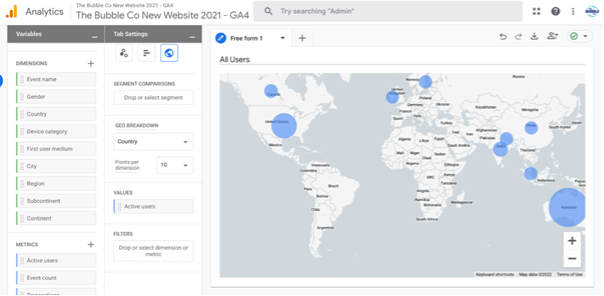Google Analytics 4 is the latest iteration of analytics that will become the sole experience from July 2023. While there’s quite a bit of lead time, it’s best to prioritise this update sooner rather than later. Here’s your complete guide to what to expect with Google Analytics 4, and what the updates mean for your ad campaigns for your business.
What are the major updates?
Google Analytics 4 (GA4) is set to ultimately improve customer journey tracking and engagement analytics, which will mean more refined and meaningful insights to help you tailor your paid and organic marketing strategies even further.
GA4 operates across platforms – notably separating desktop and app activity. This means you will be able to track the multi-modal journey as a single user moves between platforms, identifying the exit and entry points across each device and how long they spend on each.
GA4 is also focused around an event-based data model for measurement. What this means is that we won’t be seeing data insights built around ‘sessions’ as we do in Universal Analytics (UA), but rather around users and events, where each user interaction is recorded as a standalone event such as a page view, transaction, or click.
As well as this GA4 hones in on better quality engagement. In GA4 there is no bounce rate or session measurement; rather you’ll see metrics such as engagement rate, engaged sessions per user (based on events), and engagement time. All of these, combined with what we know about content that addresses Google’s algorithm updates provide a better insight in user engagement and online journeys.
Simplified event tracking
This is one of the most exciting upgrades to Analytics (in our opinion, anyway!). In UA, each event needs to be set up individually via site tags or Google Tag Manager. Happily, GA4 can automatically catch several events such as page views, scrolls and outbound link clicks as default, which means no additional tags or code implementation required. Win!
Under GA4, events are categorised under four categories:
1. Automatically collected events
These are the events that can be automatically tracked once you add the GA4 tag to your site, such as the first time a user visits a site or app, and how they engage.
2. Enhanced measurement events
These are events such as page view, scroll, outbound click, site search and file download, and can be turned on or off manually depending on what you would like to see in the data reports. By default, enhanced measurement events are enabled.
3. Recommended events
These are divided into industries, though you can use any recommended event listed by Google. If you want to track a particular action, check if it is listed as an automatically collected event or an enhanced measurement event first, before adding in a recommended event.
4. Custom events
Here’s where you can create your own events and event names. This is good if you want to check clicks on a CTA button, or anything else that isn’t listed as a Recommended Event.
So, what about the changing nature of user privacy?
GA4 does not rely on cookies for data collection, which is a good thing given that users can block cookies and opt out of data sharing. To fill in the gaps as much as possible, GA4 implements machine learning and AI in its data capture, which ultimately means more accurate audiences for Google Ads and better targeting.
How does reporting look in GA4?
Unlike UA, GA4 does not offer predefined reports and has different focus metrics to UA, so the interface does look a little different than what you may be used to. That said, there are more options for visual data analysis and granular reporting so that your insights are more detailed than ever. Here’s a peek of what to expect on the GA4 reporting interface:
One key feature to note is ‘Explorations’, which allows you to drill down into the data by dragging and dropping variables onto a page so that it’s tailored to your exact needs.
Access the tool by clicking ‘Explore’ in the left-hand menu, then customise a ‘Canvas’ (consider it a mini dashboard), with different visualisations such as charts, scatter plots or maps. You can also sort data based on common attributes such as gender or location, and even get an at-a-glance look at how users complete certain tasks on your site or app, to help you optimise user experience.

Upgrade sooner, rather than later
If you upgrade to a GA4 property you won’t lose any of your Universal Analytics data, but it is still worth implementing as soon as possible, to familiarise yourself with the features and the new methods of data capture. Setting up a GA4 property to run alongside UA means you can start collecting data and learnings that will make your future analyses (and consequent changes to marketing strategies) more meaningful.
GA4 is still in its early days and there will be more features and functionality changes to come. Bookmark this page as a handy reference and we’ll keep it updated as more information becomes available.




